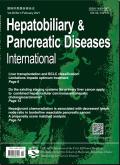Novel drug targets for the early treatment of acute pancreatitis: Focusing on calcium signaling
IF 4.4
3区 医学
Q2 GASTROENTEROLOGY & HEPATOLOGY
Hepatobiliary & Pancreatic Diseases International
Pub Date : 2025-06-06
DOI:10.1016/j.hbpd.2025.06.001
引用次数: 0
Abstract
Acute pancreatitis (AP) is a common but potentially devastating disease characterized at onset pathophysiologically by premature activation of digestive enzymes within the pancreas. Despite an abundance of preclinical research and, until recently, a series of disappointing clinical trials, no specific disease modifying pharmacological treatment has yet been approved for this condition. Recent novel approaches to understanding the molecular pathogenesis of AP provide us with renewed optimism for translational drug discovery. Although digestive enzyme activation is the hallmark of AP, a critical mechanism that initiates AP is intracellular calcium (Ca2+) overload in pancreatic parenchymal cells, which triggers mitochondrial dysfunction, endoplasmic reticulum (ER) stress, and impairs autophagic flux. These processes are pivotal to the disease and present a range of drug targets, associated with the inflammatory responses that drive local and systemic inflammation in AP. Progress in translation has now been made, targeting the ORAI channel with the inhibitor zegocractin (Auxora) to reduce pancreatic injury and inflammatory responses in human AP. Herein we evaluated potential drug targets for the early treatment of AP, focused on intra-acinar mechanisms of injury central to the onset and severity of AP. Our analysis highlights the opportunities and progress in translating these molecular insights into clinical therapies.
急性胰腺炎早期治疗的新药物靶点:关注钙信号。
急性胰腺炎(AP)是一种常见但具有潜在破坏性的疾病,其发病病理生理特征是胰腺内消化酶的过早激活。尽管有大量的临床前研究,直到最近,一系列令人失望的临床试验,还没有特定的疾病修饰药物治疗被批准用于这种情况。最近对AP分子发病机制的新认识为转化药物的发现提供了新的希望。虽然消化酶激活是AP的标志,但启动AP的一个关键机制是胰腺实质细胞内钙(Ca2+)超载,这会引发线粒体功能障碍,内质网(ER)应激,并损害自噬通量。这些过程是疾病的关键,并提出了一系列药物靶点,与驱动AP局部和全身炎症的炎症反应相关。现在已经取得了进展,用抑制剂zegocractin (Auxora)靶向ORAI通道,以减少人类AP的胰腺损伤和炎症反应。在这里,我们评估了AP早期治疗的潜在药物靶点。我们的分析强调了将这些分子见解转化为临床治疗的机会和进展。
本文章由计算机程序翻译,如有差异,请以英文原文为准。
求助全文
约1分钟内获得全文
求助全文
来源期刊
CiteScore
5.40
自引率
6.10%
发文量
152
审稿时长
3.0 months
期刊介绍:
Hepatobiliary & Pancreatic Diseases International (HBPD INT) (ISSN 1499-3872 / CN 33-1391/R) a bimonthly journal published by First Affiliated Hospital, Zhejiang University School of Medicine, China. It publishes peer-reviewed original papers, reviews and editorials concerned with clinical practice and research in the fields of hepatobiliary and pancreatic diseases. Papers cover the medical, surgical, radiological, pathological, biochemical, physiological and historical aspects of the subject areas under the headings Liver, Biliary, Pancreas, Transplantation, Research, Special Reports, Editorials, Review Articles, Brief Communications, Clinical Summary, Clinical Images and Case Reports. It also deals with the basic sciences and experimental work. The journal is abstracted and indexed in SCI-E, IM/MEDLINE, EMBASE/EM, CA, Scopus, ScienceDirect, etc.

 求助内容:
求助内容: 应助结果提醒方式:
应助结果提醒方式:


